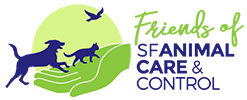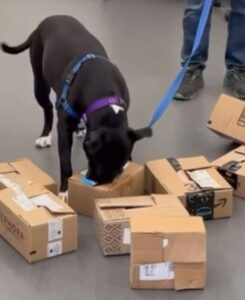By Carri Lucas
SFACC Volunteer
Enterprising Dog Volunteer Carri Lucas recently started an enrichment program for SFACC dogs and volunteers after taking a class called “Nose Work Enrichment for Shelter Dogs.” She’s been coordinating sessions on Saturdays for several weeks using low-tech resources—empty boxes and shelter treats—and the dogs love it! Thanks to Carri, many volunteers have learned and participated in this stress-relieving activity. Carri shared with us her inspiration for starting the sessions and how it works.
I became interested in enrichment methods for dogs when I took a class here at ACC which was given by a member of our Behavior and Training team, Mary Giuffrida. She taught us ways that we could provide enrichment for the dogs in our shelter with food puzzles that you can make by using egg cartons, cereal boxes, and so on. The game for the dog is to use his/her brain and sense of smell to find the treats hidden in these items and figure out how to get at them. There are many forms of enrichment that dogs can participate in, but Mary’s class showed us things we can easily do in an animal shelter. She opened up a whole new world for me of understanding that all dogs need activities that stimulate them mentally. The added bonus is that play like this can be a stress reducer and even help with behavior issues.
So, when Lauren Taylor from SFACC’s Behavior and Training team told me about an online class titled, “Nose Work Enrichment for Shelter Dogs,” I signed up for it immediately. The course instructor does nose work with dogs at a Southern California animal shelter and I thought maybe we could do this at SFACC. The teacher from the course emphasized that nose work for shelter dogs has many benefits:
- Enriching because dogs get to express naturally occurring behaviors
- Mentally and physically exhausting
- Stress buster
- Teaches focus
- Helps prevent behavioral deterioration
- Fun activity for staff and volunteers
How it works
First, we start all the dogs on something easy: four to six boxes all in a straight line with their tops open. One of the boxes contains a high value treat. That is called the “dirty” box.
The handler comes into the room with the dog and says one word, one time: “Search.” When the dog finds the box with the treat, we all say “Good dog!” with great enthusiasm. We then set up the course again, putting the dirty box in a different location in the line. Kind of like a shell game. We run the dog through this course several times until it is no longer a challenge. Then we close the tops of the boxes. When that becomes too easy (the dog finds the treat in the dirty box almost immediately,) we put the boxes with their tops closed into an array and no longer in a straight line. Maybe one on top of another, some on their sides or upside down.
Well, Legend (now adopted) advanced quickly as you can see from this video.
Dogs search differently. Legend is a very methodical searcher. Even after he found the treat in the dirty box, he went back to see that he hadn’t missed anything. And he has a great nose. The first box he keyed on didn’t have a treat in it but we had used it prior as “dirty” box so it still had a scent. That was human error. But Legend was able to triumph over that. He is one smart dog.
Based on NACSW (National Association of Canine Scent Work) methodology, nose work enrichment for shelter dogs is uniquely successful because the dogs get the perception of having control in an environment where they have very little control of anything. They self-reward.
We have a new nosework superstar: Pink! Lots of closed boxes, a tiny piece of hot dog hidden in one, was no challenge for Pink. Watch her go! Come by and meet this budding genius and all-around sweet dog! She is available for adoption.


